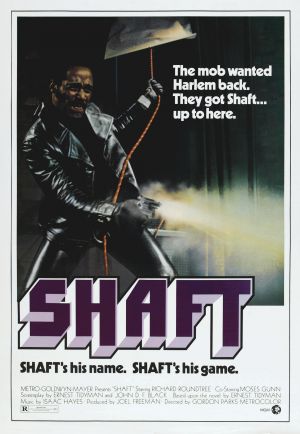
Don’t let your mouth get your ass in trouble.
Of the founding fathers of the blaxploitation genre, Shaft was mainstream Hollywood’s first foray into ethnocentric entertainment geared towards black urban audiences. Before then, Hollywood merely churned out stories from a white viewpoint. From the first silent blockbusters throughout the sixties, minorities only played supporting rolls; the maid, the laundry attendant, and the occasional villain or seductress were the limited acting choices of the day.
But from the ashes of the Civil Rights struggle in the ’60s, the ’70s gave the first opportunities to black writers, directors, and actors to explore what was once considered noncommercial topics. At the start of the Disco daze, audiences began to clamor for these nontraditional movies. Stories from destitute projects, the pervasive drug culture, and gang violence were theirs to share. For the first time, real struggles and concerns were not only portrayed on screen–
They were conquered.
Like in Shaft, where a headstrong detective is called upon by a gang to help find the leader’s daughter-kidnapped by none other the rival mob. Shaft shoots the bad guys, ambushes the men sent to kill him, and reports to his white boss at the NYPD with a kind of biting snark that told the precinct: “I can do this by myself.” But the tough guy has a soft spot for his wife, and a laughably classic seventies-esque love scene is our reward. The movie looks its age: the images are grainy, the mob and Shaft chase after each other in platform shoes, Times Square looks like it does before the clean up of the eighties (think porn theaters instead of tourist shops), and bright red “blood” would pour out of those unfortunate enough to get shot. Oh, how the times have changed.
In many of the blaxploitation films, powerful hyper-sexualized protagonists fought discrimination, drug dealers, corrupt cops, and mobsters. Minorities both led and triumphed in these films like they had never before in history. They were both cool and unmoved when situations took a serious tone. Fighters like Foxy Brown must fight against her brother’s killers and Vietnam vets return home to a racial war zone. Even Shaft has a moment where the titular detective comes to term with his mortality. Throughout impossible odds (see also: improbable), characters walk away with their revenge and lover for a happily ever after.

But for all the positive messages of triumph over evil discrimination, the movie portrays its characters through a distorted lens. As I mentioned before, most of the leading actors and actresses are hyper-sexualized, almost caricatures of stereotypes. Feminists may find these movies nauseating to watch as the women are treated as objects or worse. Domestic abuse is glamorized or expected in relationships. Even the strong leading lady, Foxy Brown, is considered a “woman that must be tamed.” Shaft clearly talks down to all in his life, his wife included. Racial slurs run freely from both sides, good and bad. Another downfall of the genre is the tendency of the characters to partake in illegal activities. Pimps and drug lords in Superfly were rampant. Many critics blame these movies for perpetuating the stereotypes of criminal culture.

Some forty years from the age of Aquarius, a new cult film was making rounds in late night showings. Black Dynamite, a spoof on the genre, has reinvigorated interest in the history of the movement. Poor production value, over-the-top acting, timely editing, and the tackiest clothing of the seventies have made it into one of the most enjoyable commentary on the genre and its commercial draw. I say commercial because for the first half of the seventies, blaxploitation films usually made quite the box office. But thin plots and an over-saturation of the movie market whittled down the genre to phase out by the end of the decade. Sporadic tributes, sequels, and spoofs punctuated the following years. Black Dynamite is just the latest success story of making fun of a serious subject. Its wit is hidden behind the ridiculous plot and dialogue. The color is just a tad faded, off-color jokes end up in a climax that leads all the way to the top of the list of corruption.

I recommend checking out Shaft, the fore-father of the genre, and Black Dynamite, the screwy send-up of the aforementioned genre. Serious issues like drugs and poverty are Kung-Fu’ed to destruction. For the strides towards regaining fortune and honor, there were many steps backwards in terms of gender equality and breaking stereotypes. Pros and cons, you get to make the decision for yourself. View a good example of the original era and a recent satire over some popcorn and see what has influenced filmmakers like Spike Lee to Quentin Tarantino. The rich and varied history of underground cinema hold many secrets, and blaxploitation is merely one of many.
“They say this cat Shaft is a bad mother… / SHUT YOUR MOUTH! / I’m talkin’ ’bout Shaft. / THEN WE CAN DIG IT!”
Strap on your Disco leisure suit, there’s plenty of good music too! Shaft:B+, Black Dynamite: A-

Black Dynamite changed my life. Shaft is now on my list of movies to watch.